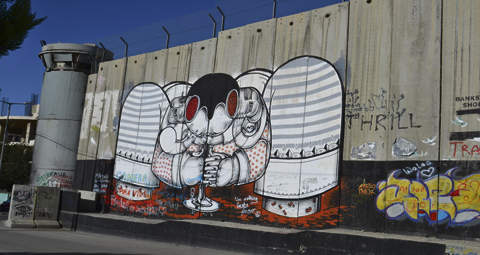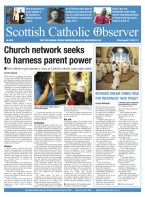June 13 | ![]() 0 COMMENTS
0 COMMENTS ![]() print
print

Peace through small gestures
JOHN NEWTON from AID TO THE CHURCH IN NEED, who was in the Holy Land in the run up to Pope Francis’ visit, describes the local Church’s challenges and triumphs
“Palestinians have difficulties—every time they need to go to Jerusalem they need a permit,” Bishop William Shomali told the small group from Aid to the Church in Need that was visiting the Holy Land. He was describing the problems that those living in the West Bank experience if they want to visit the Holy Sepulchre in Jerusalem.
Staying in Bethlehem it only took us 10 minutes to travel to Jerusalem by bus, and as a group of foreign visitors to Israel, the security checkpoints were a mere formality. We were able to freely pass between the two areas. But if a Palestinian wants to travel to Jerusalem they need a permit to pass through the West Bank Barrier—a 420-mile structure built to prevent a repeat of the attacks on civilians that occurred during and after the second intifada. Although for much of its length the barrier is little more than a chain-link fence topped with barbed wire, the area around Bethlehem is a 26 feet (8m) high concrete wall incorporating security towers.
Permits can be difficult to obtain and Bishop Shomlai told us: “[Palestinian Christians] are given permits for Easter and Christmas, for sure—but not everyone gets a permit.”
The allocation of permits can seem arbitrary with some members of the family being granted permission, while others are denied access. When we visited Beit Jala Seminary near Bethlehem, we were told by Fr Jamal that a lack of permits had meant that Palestinian seminarians are not able to attend the ceremonies in Jerusalem’s Holy Sepulchre which are held on Saturdays in Lent.
In addition to this the security wall has affected the livelihoods of those living in the West Bank. Palestinian farmers who have been cut off from their fields by the Barrier have frequently complained that they are not given free access to their lands by the military. And sometimes tragedy occurs. This March, Israeli soldiers shot and killed a 15-year-old Palestinian boy, Yusif Sami Shawamreh, when he and some friends made their way through a hole in the barrier in the western part of Hebron. The three boys were looking for gundelia, an edible plant that grows in the area.
When Pope Francis stopped to pray at the West Bank barrier during his recent trip he highlighted the problems faced by those hemmed in by the security wall, but until the tensions that exist between Israel and Palestine are resolved these problems will continue to affect those living in the West Bank.
‘We all desire peace—many people build it each day with small gestures,” Pope Francis said during his recent visit to Bethlehem. One community which is living out this important message of peace for everyone living in the Holy Land is the Benedictine Community in Tabgha on the shores of Lake Galilee.
The Benedictines arrived there in 1939 to take care of the site which, according to local tradition, marks the site of Jesus’s feeding of the 5000. The Prior, Fr Elias, warmly welcomed a small group from the Aid to the Church in Need that visited the Church of the Multiplication of the Loaves and the Fishes to see the community’s vital peace building efforts which the charity has supported.
Fr Elias, who originally comes from Germany, told me about their ongoing work for people living with disabilities—particularly young people—from both Israel and the Palestine. Their youth activities have been greatly helped by the new oratory, which ACN funded.
“We are very thankful to the benefactors of Aid to the Church in Need in the UK for their support and we keep you in our prayers,” Fr Elias insisted. He went on to explain that that the new oratory is ‘not just for the Catholic community but also for ecumenical and interfaith work.’
The German Benedictine told me a story about a group of disabled youths from Jewish backgrounds being deeply moved to hear the psalms chanted there. The riches of these scriptural songs have a power to unite all those who believe in the one God. Fr Elias described how, as part of the Benedictine tradition of hospitality, the community in Galilee has a particular ministry to provide a place of peace and inner healing. Among those it welcomes on a regular basis are disabled children who were wounded as a result of the Israeli-Palestinian conflict, as well as holocaust survivors and people born in concentration camps who now live with some sort of handicap.
One of the distinct features of the Benedictine’s ministry is that it works with groups from both Israel and Palestine. However, the region where the Benedictines are based, next to Lake Tiberias, is subject to seismic tremors, which were putting a question mark over whether they could continue to use the existing monastic building and guesthouse. But without somewhere to receive these groups they would not have been able to continue with their important work building peace through ‘small gestures,’ to use Pope Francis’s phrase.
When the community first turned to ACN for help with a quake-proof oratory, Fr Jeremias explained why the monks were undertaking the new building project.
“The first is that the house in which we live is not safe—in Germany it would have been condemned,” he said. “The rooms are always 45°C [113°F], we have cracks in the walls, and the house is moving, as we live in an area of earthquakes in the Jordan valley.
“The second reason is more important, we not only need a house—we need a cloister where the monastic life can increase and grow.”
There was no oratory or cloister in the original monastery, but the community wanted a new prayer space that gave visiting groups a place to reflect quietly and where the monks could devoutly recite part of their daily office away from the up to 5000 visitors that can visit the church every day during the busiest part of the year.
The church itself was built in 1982 on the foundations of a fifth-century church destroyed during the Persian invasion of the region in 614 AD. Fr Elias showed me the remains of the original mosaic floor, which have been incorporated into the new church. This includes a mosaic of two fishes and four loaves immediately in front of the altar—the altar itself is built over the rock that local tradition believes Jesus stood on when He performed the miracle. Asked why there were only four loaves in the basket depicted in the mosaic, Fr Elias explained that ‘the fifth loaf is the bread of the Eucharist when Mass is celebrated.’
Pope Francis has made links between the Holy Eucharist and living out our Faith. He said: “In the Eucharist the Lord makes us walk on his road, that of service, of sharing, of giving.” Here on the shores of Lake Galilee, the Benedictines are walking on that road with the Lord, and, through small acts of love, are helping pave the way to a more peaceful future in the region.










